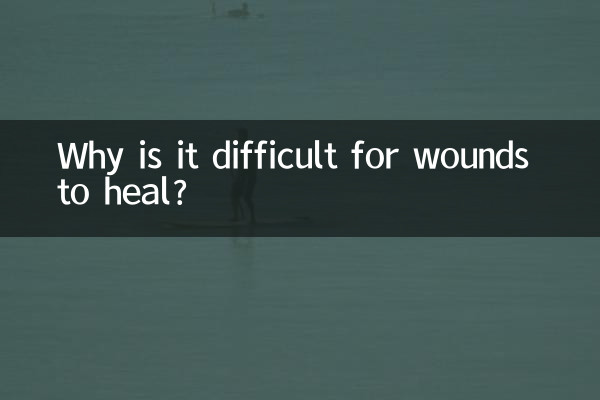Why is it so difficult for wounds to heal? ——Analyzing the difficulties of wound healing from a scientific perspective
Wound healing is a natural repair process of the human body, but sometimes wounds are delayed in healing and may even cause infection or other complications. What exactly causes wounds to be difficult to heal? This article will combine the hot topics and hot content on the Internet in the past 10 days, analyze the difficulties of wound healing from a scientific perspective, and provide structured data to help readers better understand this issue.
1. Basic process of wound healing

Wound healing is usually divided into four phases: hemostatic, inflammatory, proliferative, and remodeling phases. Each stage requires the participation of specific cells and molecules, and problems at any stage may lead to delayed healing.
| stage | Main process | Key Engagement Factors |
|---|---|---|
| hemostatic period | Blood vessels constrict and platelets aggregate to form thrombus | Platelets, coagulation factors |
| inflammatory phase | Remove pathogens and necrotic tissue | White blood cells, inflammatory factors |
| proliferative phase | Granulation tissue formation, angiogenesis | Fibroblasts, collagen |
| Reshaping period | Collagen remodeling, scar formation | matrix metalloproteinase |
2. Common causes of wounds that are difficult to heal
According to recent hot research and clinical observations, the following factors may cause difficulty in wound healing:
| Reason Category | specific factors | Influence mechanism |
|---|---|---|
| systemic factors | Diabetes, malnutrition, immune deficiency | Interfere with cellular metabolism and immune response |
| local factors | Infection, ischemia, foreign body residue | Disruption of the healing microenvironment |
| treatment related factors | Improper dressing selection, antibiotic misuse | Inhibits normal healing process |
| age factor | Decreased skin repair ability in the elderly | Cell regeneration slows down |
3. Recent hot research and new discoveries
In the past 10 days, research on wound healing has mainly focused on the following aspects:
1.The relationship between the microbiome and wound healing: Latest research has found that an imbalance in the microbial community on the wound surface may lead to the formation of chronic wounds. Certain harmful bacteria can form biofilms that hinder the healing process.
2.Breakthrough in new dressing technology: Scientists have developed a dressing with intelligent response function that can release drugs or growth factors according to the wound status, significantly improving healing efficiency.
3.Stem cell therapy applications: Mesenchymal stem cells have shown great potential in promoting chronic wound healing, and relevant clinical trials are being carried out in many centers around the world.
| field of study | Main findings | Potential applications |
|---|---|---|
| microbiome | Specific flora associated with chronic wounds | Precise antibacterial treatment |
| smart dressing | pH responsive drug release system | Diabetic foot ulcer treatment |
| stem cell therapy | Promote angiogenesis and tissue regeneration | Refractory wound repair |
4. Practical suggestions for promoting wound healing
Based on the latest research and clinical experience, we summarize the following recommendations for promoting wound healing:
1.Keep the wound clean: Use appropriate cleanser to avoid infection.
2.nutritional support: Make sure you consume enough healing-promoting nutrients such as protein, vitamin C and zinc.
3.Control underlying diseases: Diabetic patients should strictly control blood sugar levels.
4.Choose the right dressing: Use appropriate dressing according to wound type and stage.
5.avoid smoking: Nicotine constricts blood vessels and reduces blood supply to wounds.
5. Future Outlook
With advances in biotechnology and materials science, the field of wound healing is undergoing revolutionary changes. Emerging approaches such as gene therapy, 3D bioprinted skin and tissue engineering technologies have the potential to revolutionize the way we treat difficult-to-heal wounds. At the same time, the development of personalized medicine will allow us to develop optimal treatment plans based on a patient's specific situation.
In short, difficulty in wound healing is the result of a combination of factors. By understanding these factors and taking targeted measures, we can significantly increase the success of wound healing and improve patients' quality of life.

check the details

check the details